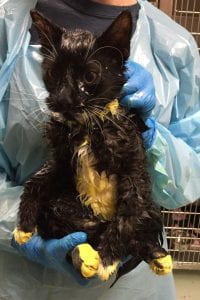Ringworm (also known as dermatophytosis) is a familiar problem for children and cats, though this fungal skin infection can affect most mammalian species. Ringworm infections are mild and self-resolving in most circumstances, but the challenge is the possibility of intraspecies and zoonotic spread.

In animal shelters, where pets are often in close contact with people and one another, treatment is important to minimize the chances of outbreak or spread to staff and to reduce the length of time spent waiting for adoption. Unfortunately, the discomfort of treatment is frequently worse than the disease itself.
Treatment for ringworm in shelters takes many weeks, and generally involves two steps: twice weekly bathing with medicated products and daily oral anti-fungal medication. Thanks to research from the University of Wisconsin, oral medication options have significantly improved in recent years, from dangerous or extremely expensive, to safe, inexpensive and FDA approved. Recommended topical treatment, in the form of foul smelling and corrosive lime sulfur baths, hasn’t changed much in 50 years. Although inexpensive, safe and effective, the entire building stinks like overcooked eggs. It’s safe to say that nobody, cat, dog, or human, likes lime sulfur.
Several new topical products with anti-fungal properties have been introduced to the market over the last few decades, but very little formal testing has been undertaken to see how these treatments compare to lime sulfur in practice. Recently, Canada has banned lime sulfur, and some companies have discontinued their product lines. Without clinical trials, shelters and veterinarians are left to trust product manufacturer’s claims or shy away from innovation. If a sweet-smelling shampoo could cure a kitten in the same amount of time, treatment compliance and animal welfare might both improve.

Dr. Lena DeTar, Assistant Clinical Professor in the Maddie’s® Shelter Medicine Program at Cornell University College of Veterinary Medicine, and her co-investigators from Toronto Humane Society and the University of California at Davis have just been awarded a generous grant by Cornell’s Feline Health Center to study two of these new products. The multi-center year-long collaborative project aims to determine which topical product best compares to the speed and effectiveness of lime sulfur in four shelters across North America. This study builds on previous research on the epidemiology, diagnosis, and treatment of shelter cats with ringworm by Dr. DeTar and members of her group.
“Dermatophytosis is such a challenge for shelters to treat,” Dr. DeTar said, “so anything we can do to make it take less time and be less unpleasant for the kittens and shelter staff is worth it.” This study will wrap up in the summer of next year, and she looks forward to having clearer guidance to provide to shelters and veterinarians treating animals infected with ringworm.
~Information provided by Dr. Lena DeTar

